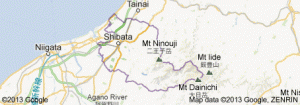Key City: Shibata is another example of a city that prospered and grew around a castle. The castle was founded in the 1590’s by Mizoguchi Hidekatsu, but it wasn’t completed until the mid 1600’s by his great-grandson. At the height of its power, the castle was made up of 11 keeps and 5 gatehouses. By all accounts it was a sight to behold.
This type of castle was constructed of wood and usually built next to a lake or surrounded by a moat. If you visit the castle today, you can walk through the
remaining gatehouse, but visitors aren’t allowed to cross the moat.
At that time, one of the greatest threats to large structures was fire. They didn’t have access to reliable fire-prevention methods or fire extinguishers, so if a wooden building caught fire, it had to be dealt with quickly or the building was surely lost. Imagine constructing a castle complex like Shibata all made of wood. You’d be worried too!

There is actually some rationale behind it. In the country of India, the god of water supposedly rode on similar creatures, and when Buddhism made its way into China and eventually Japan, it brought this symbolism with it. Mizoguchi Hidekatsu followed the 
Not to be too heavy-handed with this, but can’t you see the spiritual lessons to this story? If only there had been someone to say, “Let me introduce you to the God who can protect you from fire for all eternity!” Will you pray for Shibata, a city with over 100,000 people destined for a fiery eternity?


